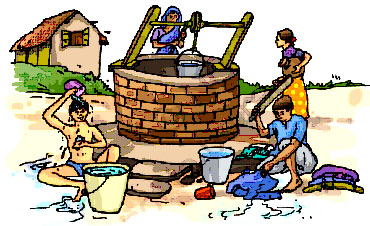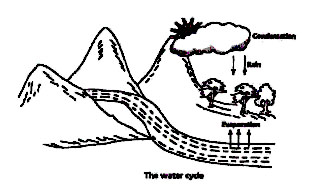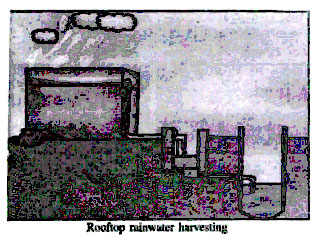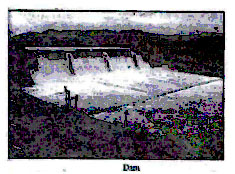INTRODUCTION
We all depend on the same vital substance water, diverse by its nature, it is solid, vapour and liquid. It is in the air, on the earth
surface and within the ground ever-changing and giving shape to a dramatic range of natural ecosystems. For the earth's
inhabitants, diversity of the resource also means great disparities in well being and development . As we degrade the quality
of our water and modify the natural ecosystems on which people and life depend, we also threaten our own survival.
AVAILABILITY OF WATER
Water is the most widely occurring substance on this planet. Globally distributed by the hydrological cycle, or driven by the energy
cycle, the circulation of water powers most of the other natural cycles and conditions the weather and climate. Water has shaped
the earth's evolution and continues to fashion Its programmes. This is the water precipitated from the atmosphere on to land,
where it may be stored in liquid or solid form, and can move laterally and vertically and between one phase and another phase
by evaporation, condensation , freezing and thawing on the land surface. We are aware that about 71 % of the earth's surface
Is covered with water. Almost all the water on the earth is contained in the seas and oceans, rivers , lakes, ice caps, as
groundwater and in the atmosphere. However, most of this water is not fit for human consumption.
1. Pure water is a colourless, odourless, tasteless, transparent liquid.
2. Water exists in all he three states, solid (as ice), liquid (as water) and gas (as water vapour).
FORMS OF WATER
When water circulates through the water cycle it can be found in all the three forms i.e., solid , liquid and gas -at any given
time somewhere on the earth. The solid form, snow and ice, is present as ice caps at the poles of the earth, snow covered
mountains and glaciers. Liquid water is present in oceans, lakes, rivers and even underground. The gaseous form is the
water vapour present in the air around us. The continuous cycling of water among its three forms keeps the total amount
of water on the earth constant.
WATER CYCLE
The supply of water in nature does not run out. This is because water is continuously recycled in the water cycle.
1. Heat from the sun causes the water on the earth's surface to evaporate. The vapour rises, cools and condenses to
form tiny water droplets. These droplets form clouds.
2. The clouds get carried along by air currents. They cool and the droplets join to form larger drops. These fall as mist.
3. If the temperature in the region is very low, these water droplets fall as hail, sleet or snow.
4. Some of the rain water flows along the ground as streams. Some soaks through the ground and then reappears
as springs. Streams and springs join to form rivers. Rivers flow back into the sea. Thus the water cycle is complete.
IMPORTANT SOURCE OF WATER
Ground water is an important source of water. If we dig a hole in the ground near a water body we may find that the
soil is moist. The moisture in the soil indicates the presence of water underground. If we dig deeper and deeper, we
would reach a level where all the space between particles of soil and gaps between rocks are filled with water. The
upper limit of this layer Is called the water table. The water table varies from place to place, and it may even change
at a given place. The water table may be at a depth of less than a metre or may be several metres below the ground.
The water found below the water table is called groundwater. What is the source. of this groundwater ? The rainwater
and water from other sources such as rivers and ponds seeps through the soil and fills the empty spaces and cracks
deep below the ground. The process of seeping of waler into the ground is called infiltration . The groundwater thus
gets recharged by this process. At some places the groundwater is stored between layers of hard rocks below the
water table. This Is a known as a aquifer. Water in the aquifers can be usually pumped out with the help of tube
wells or handpumps. We have at many places in India an age old practice of water storage and water recharge
like the bawris. bawris was the traditional way of collecting water.
DEPLETION OF WATER TABLE
Increase in population, industrial and agricultural activities are some common factors affecting water table.
Scanty rainfall is another factor that may deplete the water table.
(a) Increasing population:
Increasing population creates demand for construction of houses, shops, offices, roads and pavements.
This decreases the open areas like parks and playgrounds. This, in turn, decreases the seepage of rain
water into the ground. Moreover a huge amount of water is required for construction work. Often
groundwater is used (or this purpose).
So, on one hand we are consuming more groundwater, and on the other we are allowing lesser
water to seep into the ground.
(b) Increasing Industries :
Water is used by all the industries. Almost everything that we use needs water somewhere in its
production process. The number of industries is increasing continously. Water used by most of the
industries is drawn from the ground.
WATER MANAGEMENT
We have seen that most of the water that we get as rainfall just flows away. This is a waste
of precious natural resource The rainwater can be used to recharge the groundwater.
This is referred to as water harvesting or rainwater harvesting. We have at many places
in India an age old practice of water storage and water recharge like the bawris Bawri
was the traditional way of collecting water. With time the bawris fell into disuse and
garbage started piling these reservoirs. However, because ofthe acute water shortage,
people In these areas have had to rethink. The bawaris are being revived. Today the
situation is that inspite of scanty rains these places are managing their water needs
well. A farmer using water in the field can also use water economically. May be you
have heard of drip irrigation. Drip irrigation is a technique of watering plants by
making use of narrow tubings which deliver water directly at the base of the plant.
EFFECT OF WATER SCARCITY ON PLANTS
Plants need water to get nutrients from the soil to prepare their food . Just imagine the conse quences if water is not available to plants.
The green character of the planet shall be tost This may mean the end of the life, for a wond without plants shall mean no food, no oxygen,
nol enough rain, and innumerable other problems.
OBJECTIVE QUESTIONS
1. Water which is absolutely pure and free from any impurity is known as
(A) boiled water (B) mineral water
(C) distilled wate (D) None of these
2. Solubility of sugar in water
(A) decrease with increase in temperature
(B) increase with increase in temperature
(C) is not affected by temperature
(D) None of Ihese
3. Which of these statements is true ?
(A) Density of ice is more than the density of water .
(B) Volume of ice is more than the volume of water
(C) Temperature of ice is more than the temperature of water
(D) None of these
4. Pure water is -
(A) an element (B) a compound
(C) a mixture (D) None of these
5. Water is called universal solvent because -
(A) It can dissolve all the liquids in the universe
(B) it dissolve all the gases in the universe
(C) it dissolve large number of solids, liquids and gases
(D) None of these
6. What percentage of water is in our body?
(A) 30% (B) 70%
(C) 20% (D) None of these
7. Which of these is surface water?
(A) Lakes and rivers
(B) Wells
(C) Distilled water
(D) None of these
8. The boiling point of water on plains is 100ºC. At hills it will be ______
(A) 100ºC
(B) more than 100ºC
(C) less than 100ºC
(D) None of these
9. The purest form of natural water is -
(A) rain water (B) ground water
(C) surface water (D) None of these
10. Solubility of gases in water.
(A) Increase with increase in temperature
(B) decreases with decrease in temperature
(C) decreases with increases in temperature
(D) None of these
11. Water at room temperature is -
(A) Solid (B) liquid
(C) gas (D) None of these
12. Water has maximum density at -
(A) 0ºC (B) 10ºC
(C) 4ºC (D) None of these
13. How much of the earth surface is covered with water ?
(A) About 1/3 rd (B) About 1/4 th
(C) About 3/4 th (D) None of these
14. The liquid that dissolve in water are called -
(A) insoluble liquids
(B) miscible liquids
(C) immiscible liquids
(D) None of these
15. The ratio of the number of hydrogen atoms and those of oxygen in water is -
(A) 2 : 1 (B) 1 : 2
(C) 2 : 2 (D) None of these
SUBJECTIVE QUESTIONS
1. Explain how ground water is recharged?
2. You have been asked to maintain a garden. How would you minimise the use of water ?
3. Write equation for the following reactions.
(a) action of steam on iron.
(b) action of cold water on sodium metal.
4. Explain water cycle.
5. List the physical properties of water.
ANSWER KEY
1. C 2. B 3. B 4. B 5. C 6. B 7. A 8. C
9. A 10. C 11. B 12. C 13. C 14. B 15. A
MULTIPLE CHOICE QUESTIONS
1. Which of the following activity does not involve use of water?
(a) Washing clothes (b) Bathing
(c) Cleaning utensils (d) Drying wet clothes
2. In which of the following activities will you use minimum amount of water?
(a) Bathing (b) Brushing teeth (c) Washing clothes (d) Mopping a room
3. The quantity of water required to produce one page of your book is
(a) one bucket (b) ten buckets (c) two glasses (d) few drops
4. Water in our tap comes from a
(a) river (b) lake (c) well (d) river, lake or well
5. In which of the following case evaporation of water will be slowest?
(a) A tray of water kept in sunlight. (b) A kettle of water kept on a burner.
(c) A glass of water kept in a room. (d) A bucket of water kept on rooftop.
6. Transpiration is a process in which plants
(a) receive water from soil. (b) absorb water vapour from air.
(c) prepare food from water. (d) release water vapour.
7. Clouds are
(a) tiny drops of water floating in air. (b) mixture of dust and water vapour.
(c) particles of water vapour. (d) rain drops in air.
8. Wells are fed by
(a) pond water. (b) lake water. (c) rain water. (d) ground water.
9. Floods cause extensive damage to
(a) crops. (b) property and human life.
(c) domestic animals. (d) all of the above.
10. “Catch water where it falls” is the basic idea behind
(a) recycling of water. (b) making dams to store water.
(c) rain water harvesting. (d) condensation of water vapour.
VERY SHORT ANSWER QUESTIONS
11. Look at Fig. 5.1.

Write down activities shown in this figure in which water is being used.
12. Write any two activities which require more than a bucket of water.
13. Write any two activities which require less than one bucket of water.
SHORT ANSWER QUESTIONS
14. Why do wet clothes placed on a clothes line get dry after some time? Explain.
15. Water kept in sunlight gets heat from sun and is evaporated. But how does water kept under the shade of a tree also gets evaporated? Explain.
16. How do the areas covered with concrete affect the availability of ground water?
17. Why is there a need for conserving water? Give two reasons.
18. Fill in the blanks selecting words from the following list
snow, rain, clouds, vapour, evaporation, transpiration. Water, as _____ goes into atmosphere by the processes of ______ and _____ and forms
________, which on condensation fall in the form of ______ and _______.
LONG ANSWER QUESTIONS
19. Most of the water that falls on the land as rain and snow, sooner or later goes back to a sea or an ocean. Explain how it happens?
20. Draw a diagram to show how sea water reaches a lake or pond.
21. Dissolve two spoons of common salt in half a cup of water. Now if you want to get the salt back, what will you do?
22. Explain the process of rooftop rain water harvesting with the help of a suitable diagram.
ANSWER KEY
1. d 2. b 3. c 4. d 5. c
6. d 7. a 8. d 9. d 10. c
11. (i) Bathing (ii) Washing clothes
12. (i) Washing 10 clothes (ii) Irrigating a crop field
13. (i) Brushing your teeth (ii) Washing hand kerch field


